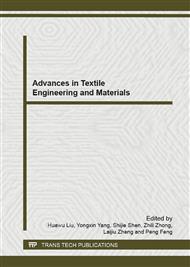p.835
p.839
p.844
p.849
p.855
p.859
p.864
p.869
p.873
Property Evaluation of Sound-Absorbent Nonwoven Fabrics Made of Polypropylene Nonwoven Selvages
Abstract:
The rapid development of textile industry at the beginning of the Industrial Revolution results in the invention of synthetic fibers. As synthetic fibers cannot be decomposed naturally, significant textile waste is thus created. Selvages, which make up the majority of our total garbage output, have a low value and thus are usually sold cheaply or outsourced as textile waste. This study aims to recycle and reclaim the nonwoven selvages which are discarded by the textile industry. The recycled polypropylene (PP) selvages, serving as a packing material, and 6 denier PP staple fibers are made into the recycled PP nonwoven fabrics. The resulting nonwoven fabrics are subsequently tested in terms of maximum tensile breaking strength, tearing strength, surface observation, thickness measurement and sound absorption coefficient.
Info:
Periodical:
Pages:
855-858
Citation:
Online since:
December 2012
Keywords:
Price:
Сopyright:
© 2013 Trans Tech Publications Ltd. All Rights Reserved
Share:
Citation:


